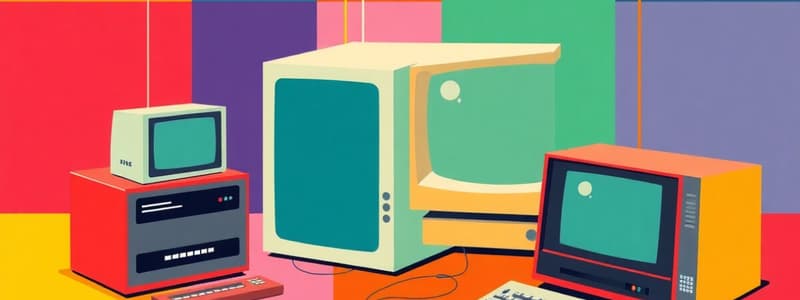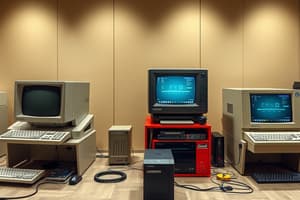Podcast
Questions and Answers
What is a characteristic of a computer?
What is a characteristic of a computer?
- It can execute a pre-recorded list of instructions. (correct)
- It can function without any instructions.
- It can only store small amounts of data.
- It responds to a limited range of instructions.
When was the first recorded use of the word 'computer'?
When was the first recorded use of the word 'computer'?
- 1500
- 1800
- 1613 (correct)
- 1750
Which of the following statements is true about an abacus?
Which of the following statements is true about an abacus?
- The abacus was invented in Greece in 500 B.C.
- Abacus users were primarily engaged in computations only.
- It is primarily used for complex mathematical theories.
- It aids individuals in performing basic arithmetic operations. (correct)
What role did humans play in computing before machines were invented?
What role did humans play in computing before machines were invented?
Which of the following describes a tally stick?
Which of the following describes a tally stick?
Which important characteristic applies to computers regarding data?
Which important characteristic applies to computers regarding data?
What statement best summarizes the evolution of the computer?
What statement best summarizes the evolution of the computer?
What best describes a programmable machine?
What best describes a programmable machine?
What was the primary limitation of the Pascaline invented by Blaise Pascal?
What was the primary limitation of the Pascaline invented by Blaise Pascal?
Which of the following machines could automatically add, subtract, multiply, and divide?
Which of the following machines could automatically add, subtract, multiply, and divide?
Who invented the first mass-produced calculating machine?
Who invented the first mass-produced calculating machine?
Which device was specifically used for calculations related to trigonometry and logarithms?
Which device was specifically used for calculations related to trigonometry and logarithms?
What was the purpose of the Jacquard Loom?
What was the purpose of the Jacquard Loom?
What concept did Napier's Bones utilize to aid in calculations?
What concept did Napier's Bones utilize to aid in calculations?
What was the primary function of the Slide Rule?
What was the primary function of the Slide Rule?
Which invention came after Napier's Bones and was related to advanced mathematical calculations?
Which invention came after Napier's Bones and was related to advanced mathematical calculations?
Who invented the Difference Engine?
Who invented the Difference Engine?
Which machine is considered the first mechanical computer?
Which machine is considered the first mechanical computer?
Who is recognized as the first computer programmer?
Who is recognized as the first computer programmer?
What was the purpose of the Tabulating Machine invented by Herman Hollerith?
What was the purpose of the Tabulating Machine invented by Herman Hollerith?
The Z1, created by Konrad Zuse, was notable for being what?
The Z1, created by Konrad Zuse, was notable for being what?
In which year was the Scheutzian Calculation Engine invented?
In which year was the Scheutzian Calculation Engine invented?
What kind of computer is the Havard Mark 1 also known as?
What kind of computer is the Havard Mark 1 also known as?
Which of the following is NOT true about the Difference Engine?
Which of the following is NOT true about the Difference Engine?
Which technology was primarily used for memory in first generation computers?
Which technology was primarily used for memory in first generation computers?
What major advancement characterized the transition from first to second generation computers?
What major advancement characterized the transition from first to second generation computers?
In which generation did computers start to use symbolic assembly languages instead of binary machine language?
In which generation did computers start to use symbolic assembly languages instead of binary machine language?
What was a common input method used in both first and second generation computers?
What was a common input method used in both first and second generation computers?
How did the size and cost of computers change from the first generation to the second generation?
How did the size and cost of computers change from the first generation to the second generation?
Which of the following statements regarding the first generation computers is correct?
Which of the following statements regarding the first generation computers is correct?
Which characteristic of second generation computers made them more reliable than first generation computers?
Which characteristic of second generation computers made them more reliable than first generation computers?
What technological innovation was significant in the third generation of computers?
What technological innovation was significant in the third generation of computers?
What was the primary technology that allowed the third generation of computers to run multiple applications simultaneously?
What was the primary technology that allowed the third generation of computers to run multiple applications simultaneously?
Which generation of computers is characterized by the integration of thousands of circuits onto a single chip?
Which generation of computers is characterized by the integration of thousands of circuits onto a single chip?
What is the main goal of the fifth generation of computers?
What is the main goal of the fifth generation of computers?
Which development allowed computers in the third generation to become more accessible to the public?
Which development allowed computers in the third generation to become more accessible to the public?
What technology contributed to the creation of networks and the Internet during the fourth generation?
What technology contributed to the creation of networks and the Internet during the fourth generation?
Flashcards are hidden until you start studying
Study Notes
Defining a Computer
- A computer is a programmable machine that manipulates data according to a list of instructions.
- Computers respond to specific sets of instructions in a well-defined manner.
- They can execute pre-recorded lists of instructions and quickly store and retrieve large amounts of data.
Early Computers
- The word "computer" was first used in 1613, referring to a person who carried out calculations.
- Tally sticks were ancient memory aid devices used to record numbers and quantities.
- The abacus, invented in Babylonia in 2400 B.C., was used to perform basic arithmetic operations.
Key Historical Devices
- John Napier invented Napier's Bones in 1614, which allowed the operator to perform calculations by moving rods around.
- William Oughtred invented the slide rule in 1622, using logarithms to perform operations like multiplication, division, and roots.
- Blaise Pascal's Pascaline, invented in 1642, was a mechanical calculator limited to addition and subtraction.
- Gottfried Wilhelm Leibniz's Stepped Reckoner, invented in 1672, could add, subtract, multiply, and divide automatically.
- Joseph-Marie Jacquard's Jacquard loom, invented in 1881, was an automatic loom controlled by punched cards.
- Thomas de Colmar's Arithmometer, invented in 1820, was the first reliable, commercially successful calculating machine.
- Charles Babbage's Difference Engine and Analytical Engine, invented in 1822 and 1834, were designed to tabulate polynomial functions. These were considered the first mechanical computers.
- Augusta Ada Byron, considered the first computer programmer, suggested Babbage use the binary system and wrote programs for the Analytical Engine in 1840.
- Per Georg Scheutz invented the Scheutzian Calculation Engine in 1843, based on Babbage's Difference Engine.
- Herman Hollerith's Tabulating Machine, invented in 1890, was used to summarize information and assist accounting.
- Howard H. Aiken invented the Harvard Mark 1 in 1943, also known as IBM Automatic Sequence Controlled Calculator (ASCC). This was the first electro-mechanical computer.
- Konrad Zuse created the Z1 in Germany from 1936 to 1938, which was the first programmable computer.
Computer Generations
- The first generation of computers (1946-1958) used vacuum tubes for circuitry and magnetic drums for memory.
- Second-generation computers (1959-1964) used transistors, which were smaller, faster, and more energy-efficient than vacuum tubes.
- Third-generation computers (1965-1970) utilized integrated circuits, leading to increased computer speed and efficiency.
- Fourth-generation computers (1971-present) were made possible by the microprocessor, which integrated thousands of circuits onto a single chip.
- Fifth-generation computers (present to future) are based on artificial intelligence (AI) and focus on parallel processing and superconductors.
- Computers evolved from using machine language to symbolic languages, allowing programmers to use words instead of binary code.
- Operating systems were introduced in the third generation, allowing computers to run multiple applications simultaneously.
- The fourth generation introduced graphical user interfaces (GUIs), the mouse, and handheld devices.
Studying That Suits You
Use AI to generate personalized quizzes and flashcards to suit your learning preferences.



